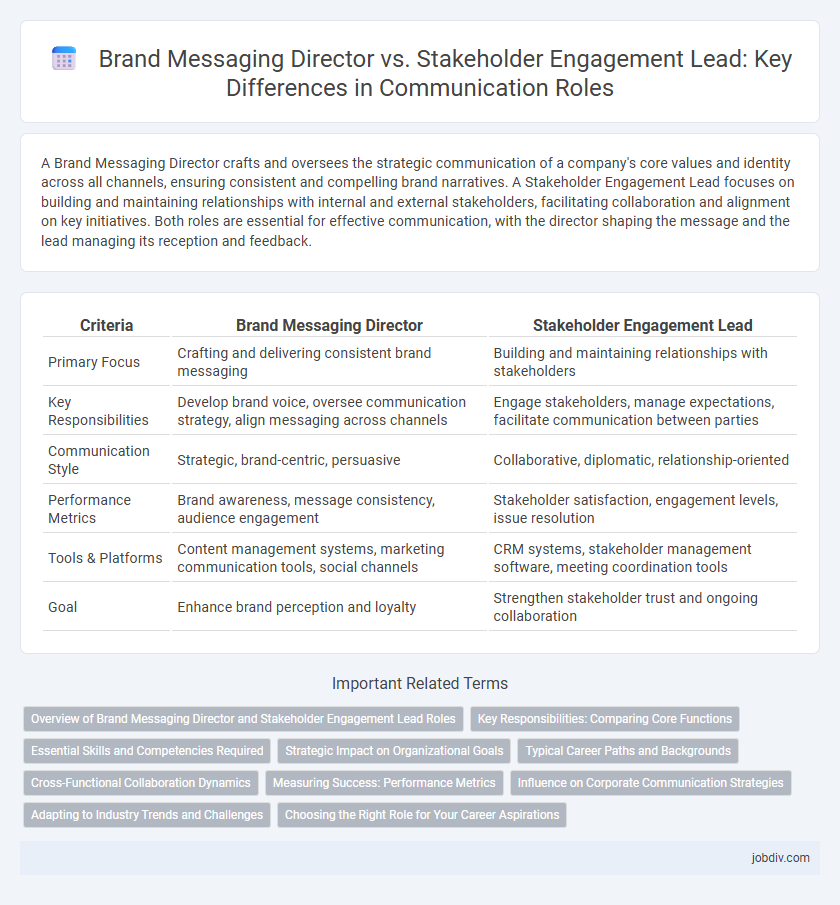A Brand Messaging Director crafts and oversees the strategic communication of a company's core values and identity across all channels, ensuring consistent and compelling brand narratives. A Stakeholder Engagement Lead focuses on building and maintaining relationships with internal and external stakeholders, facilitating collaboration and alignment on key initiatives. Both roles are essential for effective communication, with the director shaping the message and the lead managing its reception and feedback.
Table of Comparison
| Criteria | Brand Messaging Director | Stakeholder Engagement Lead |
|---|---|---|
| Primary Focus | Crafting and delivering consistent brand messaging | Building and maintaining relationships with stakeholders |
| Key Responsibilities | Develop brand voice, oversee communication strategy, align messaging across channels | Engage stakeholders, manage expectations, facilitate communication between parties |
| Communication Style | Strategic, brand-centric, persuasive | Collaborative, diplomatic, relationship-oriented |
| Performance Metrics | Brand awareness, message consistency, audience engagement | Stakeholder satisfaction, engagement levels, issue resolution |
| Tools & Platforms | Content management systems, marketing communication tools, social channels | CRM systems, stakeholder management software, meeting coordination tools |
| Goal | Enhance brand perception and loyalty | Strengthen stakeholder trust and ongoing collaboration |
Overview of Brand Messaging Director and Stakeholder Engagement Lead Roles
A Brand Messaging Director shapes and oversees the strategic communication of a company's brand identity, ensuring consistency across all marketing channels to enhance brand perception and drive customer loyalty. The Stakeholder Engagement Lead focuses on building and maintaining strong relationships with internal and external stakeholders, facilitating collaboration and effective communication to align goals and support project success. Both roles require strategic communication skills but differ in focus: brand messaging targets audience perception, while stakeholder engagement emphasizes relationship management and alignment.
Key Responsibilities: Comparing Core Functions
The Brand Messaging Director crafts and oversees the strategic communication framework, ensuring consistent and compelling brand narratives across all platforms. The Stakeholder Engagement Lead focuses on building and maintaining relationships with key internal and external stakeholders to align interests and facilitate collaboration. Core functions differentiate as the former drives brand voice and positioning, while the latter manages engagement tactics and feedback channels to foster partnership.
Essential Skills and Competencies Required
A Brand Messaging Director excels in strategic storytelling, content creation, and maintaining consistent brand voice across all platforms, requiring strong leadership, creativity, and market analysis skills. In contrast, a Stakeholder Engagement Lead focuses on relationship management, negotiation, and communication facilitation, emphasizing emotional intelligence, conflict resolution, and stakeholder mapping competencies. Both roles demand excellent interpersonal communication and project management abilities to drive organizational goals effectively.
Strategic Impact on Organizational Goals
A Brand Messaging Director shapes the company's narrative, ensuring consistent and compelling communication that aligns with organizational goals to enhance brand equity and market positioning. In contrast, a Stakeholder Engagement Lead focuses on cultivating and maintaining relationships with internal and external stakeholders, driving collaboration and support critical for project success and organizational alignment. Both roles strategically impact organizational goals by fostering clarity, trust, and alignment, but the Brand Messaging Director primarily influences external perception while the Stakeholder Engagement Lead concentrates on internal and partner engagement.
Typical Career Paths and Backgrounds
Brand Messaging Directors often have backgrounds in marketing, communications, or journalism, progressing through roles such as content strategist or marketing manager before leading brand messaging initiatives. Stakeholder Engagement Leads typically come from public relations, community relations, or corporate affairs, advancing from roles like engagement coordinator or communications specialist to manage relationships with key stakeholders. Both career paths require strong communication skills, but Brand Messaging Directors focus more on crafting and delivering consistent brand narratives, while Stakeholder Engagement Leads emphasize building and maintaining external and internal partnerships.
Cross-Functional Collaboration Dynamics
Brand Messaging Directors drive cohesive narratives across marketing, product, and sales teams to ensure consistent brand representation, leveraging in-depth market research and audience insights. Stakeholder Engagement Leads prioritize relationship-building and communication strategies with internal and external stakeholders, facilitating alignment and buy-in for organizational initiatives. The dynamic between these roles hinges on integrating brand messaging expertise with targeted stakeholder communication to foster cross-functional collaboration and unified organizational objectives.
Measuring Success: Performance Metrics
Brand Messaging Directors measure success through brand awareness metrics, message recall rates, and audience sentiment analysis to ensure consistent communication across channels. Stakeholder Engagement Leads focus on engagement levels, feedback quality, and stakeholder satisfaction scores to gauge the effectiveness of relationship-building efforts. Both roles rely on data-driven performance indicators but emphasize different aspects of communication impact and strategic alignment.
Influence on Corporate Communication Strategies
The Brand Messaging Director shapes corporate communication strategies by crafting consistent, compelling narratives that align with brand identity and target audience expectations. The Stakeholder Engagement Lead influences these strategies by ensuring diverse stakeholder perspectives are integrated, fostering trust and long-term relationships essential for brand credibility. Both roles drive effective communication, with the Brand Messaging Director focusing on message coherence and the Stakeholder Engagement Lead emphasizing relational dynamics.
Adapting to Industry Trends and Challenges
The Brand Messaging Director expertly analyzes shifting market narratives to refine communication strategies that resonate with target audiences, ensuring brand consistency amid evolving industry trends. The Stakeholder Engagement Lead navigates complex stakeholder landscapes by fostering transparent dialogue and adapting engagement approaches to address emerging challenges effectively. Both roles require agility in leveraging data-driven insights to anticipate changes, align messaging with stakeholder expectations, and maintain competitive advantage.
Choosing the Right Role for Your Career Aspirations
Brand Messaging Directors focus on crafting and overseeing strategic communication frameworks that shape a company's public image and ensure consistent brand voice across all platforms. Stakeholder Engagement Leads specialize in building and maintaining relationships with key internal and external parties, driving collaboration and aligning interests to support organizational goals. Selecting between these roles depends on whether your career aspirations lean more toward brand narrative development or relationship management within complex ecosystems.
Brand Messaging Director vs Stakeholder Engagement Lead Infographic

 jobdiv.com
jobdiv.com